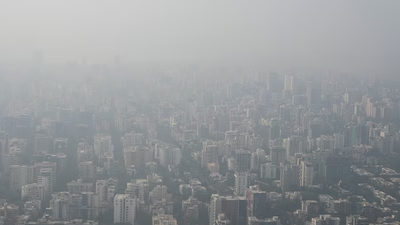Mumbai’s air quality remains a growing concern as the city faces its sixth consecutive day of dangerously high pollution levels. On Sunday, Mumbaikars awoke to a thick layer of smog, with the city’s 24-hour average Air Quality Index (AQI) hovering near the ‘poor’ category. In several areas, the air quality worsened to ‘very poor’ for extended periods, causing serious health concerns for residents.
The primary pollutants during this six-day period were Ozone and PM 2.5. Ozone, prevalent during the first three days, is formed when nitrogen oxides from vehicular emissions combine with atmospheric oxygen. In the latter half of the period, PM 2.5, a dangerous particulate matter, dominated the pollution landscape. These tiny particles are a mix of vehicular emissions, industrial discharge, and dust from construction activities, which pose severe risks to respiratory health. Prolonged exposure to these pollutants can irritate the airways, exacerbating respiratory conditions and even causing health issues in otherwise healthy individuals. Gufran Beig, chair-professor at the National Institute of Advanced Sciences (NIAS), explained that the current weather conditions in Mumbai, characterized by low humidity and high vertical wind speeds, are contributing to the persistent haze. Without water droplets to ground the pollutants, they are pushed upwards into the inversion layer, causing trapped pollutants to linger longer.
Sunil Dahiya, founder of Envirocatalysts, highlighted the role of vehicular emissions in this surge of pollution. “The primary source of pollution in Mumbai over the past six days has been vehicular emissions, with the combination of nitrogen oxides and atmospheric oxygen leading to ozone formation,” he said. Additionally, emissions from industries, power plants in the eastern suburbs, and neighboring regions like Thane, Navi Mumbai, and Mira Bhayandar have further compounded the pollution levels. Medical experts have also raised alarms about the adverse effects on public health. Dr Priti Meshram, head of pulmonary medicine at JJ Hospital, emphasized that pollutants such as ozone and PM 2.5 can worsen conditions like asthma, Chronic Obstructive Pulmonary Disease (COPD), and even lead to chronic coughs. “The ongoing viral infections combined with the pollution have made matters worse for those with respiratory illnesses,” she stated, noting that asthmatics are particularly vulnerable during such pollution spikes.
The Brihanmumbai Municipal Corporation (BMC) has responded by encouraging citizens to switch to electric vehicles (EVs) and implementing measures like cleaner fuels in bakeries. However, experts argue that the civic body must take more proactive steps to mitigate pollution, given the city’s coastal location, which typically facilitates faster dispersion of pollutants. Experts also highlighted that while Mumbai may meet the National Ambient Air Quality Standards (NAAQS) for PM 2.5, the levels remain harmful to public health. The NAAQS allows up to 40 micrograms per cubic meter of PM 2.5, but the World Health Organisation recommends a limit of 5 µg/m³, significantly lower than current levels in Mumbai. With air quality continuing to deteriorate, both environmental and public health experts are calling for stronger, more immediate actions to reduce pollution and safeguard the well-being of Mumbaikars.




